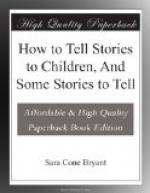There must be many ways of going about this filling in. Doubtless many of my readers, in the days when it was their pet ambition to make a good recitation in school, evolved personally effective ways of doing it; for it is, after all, the same thing as preparing a bit of history or a recitation in literature. But for the consideration of those who find it hard to gain mastery of fact without mastery of its stated form, I give my own way. I have always used the childlike plan of talking it out. Sometimes inaudibly, sometimes in loud and penetrating tones which arouse the sympathetic curiosity of my family, I tell it over and over, to an imaginary hearer. That hearer is as present to me, always has been, as Stevenson’s “friend of the children” who takes the part of the enemy in their solitary games of war. His criticism (though he is a most composite double-sexed creature who should not have a designating personal pronoun) is all-revealing. For talking it out instantly brings to light the weak spots in one’s recollection. “What was it the little crocodile said?” “Just how did the little pig get into his house?” “What was that link in the chain of circumstances which brought the wily fox to confusion?” The slightest cloud of uncertainty becomes obvious in a moment. And as obvious becomes one’s paucity of expression, one’s week-kneed imagination, one’s imperfect assimilation of the spirit of the story. It is not a flattering process.
But when these faults have been corrected by several attempts, the method gives a confidence, a sense of sureness, which makes the real telling to a real audience ready and spontaneously smooth. Scarcely an epithet or a sentence comes out as it was in the preliminary telling; but epithets and sentences in sufficiency do come; the beauty of this method is that it brings freedom instead of bondage.
A valuable exception to the rule against memorising must be noted here. Especially beautiful and indicative phrases of the original should be retained, and even whole passages, where they are identified with the beauty of the tale. And in stories like The Three Bears or Red Riding Hood the exact phraseology of the conversation as given in familiar versions should be preserved; it is in a way sacred, a classic, and not to be altered. But beyond this the language should be the teller’s own, and probably never twice the same. Sureness, ease, freedom, and the effect of personal reminiscence come only from complete mastery. I repeat, with emphasis: Know your story.
The next suggestion is a purely practical one concerning the preparation of physical conditions. See that the children are seated in close and direct range of your eye; the familiar half-circle is the best arrangement for small groups of children, but the teacher should be at a point opposite the centre of the arc, not in its centre: thus [Illustration], not thus [Illustration]; it is important also not to




